Zihan Xu
Learn the Ropes, Then Trust the Wins: Self-imitation with Progressive Exploration for Agentic Reinforcement Learning
Sep 26, 2025
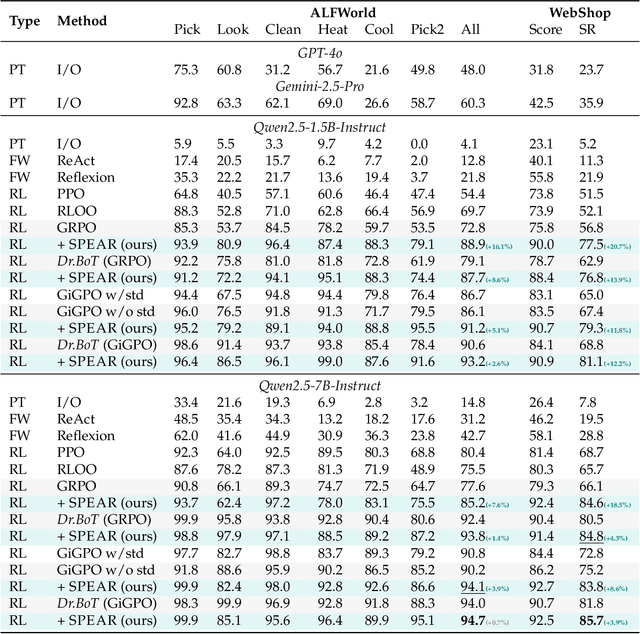
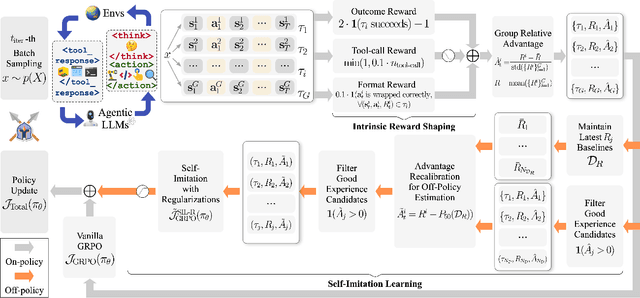
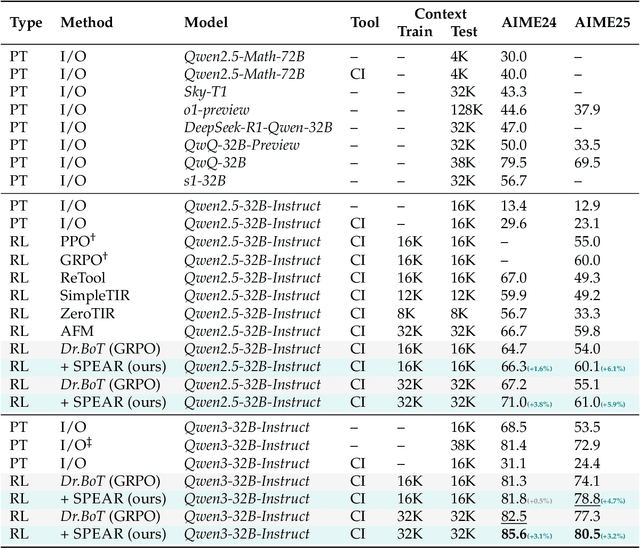
Abstract:Reinforcement learning (RL) is the dominant paradigm for sharpening strategic tool use capabilities of LLMs on long-horizon, sparsely-rewarded agent tasks, yet it faces a fundamental challenge of exploration-exploitation trade-off. Existing studies stimulate exploration through the lens of policy entropy, but such mechanical entropy maximization is prone to RL training instability due to the multi-turn distribution shifting. In this paper, we target the progressive exploration-exploitation balance under the guidance of the agent own experiences without succumbing to either entropy collapsing or runaway divergence. We propose SPEAR, a curriculum-based self-imitation learning (SIL) recipe for training agentic LLMs. It extends the vanilla SIL framework, where a replay buffer stores self-generated promising trajectories for off-policy update, by gradually steering the policy evolution within a well-balanced range of entropy across stages. Specifically, our approach incorporates a curriculum to manage the exploration process, utilizing intrinsic rewards to foster skill-level exploration and facilitating action-level exploration through SIL. At first, the auxiliary tool call reward plays a critical role in the accumulation of tool-use skills, enabling broad exposure to the unfamiliar distributions of the environment feedback with an upward entropy trend. As training progresses, self-imitation gets strengthened to exploit existing successful patterns from replayed experiences for comparative action-level exploration, accelerating solution iteration without unbounded entropy growth. To further stabilize training, we recalibrate the advantages of experiences in the replay buffer to address the potential policy drift. Reugularizations such as the clipping of tokens with high covariance between probability and advantage are introduced to the trajectory-level entropy control to curb over-confidence.
Extracting Post-Acute Sequelae of SARS-CoV-2 Infection Symptoms from Clinical Notes via Hybrid Natural Language Processing
Aug 17, 2025Abstract:Accurately and efficiently diagnosing Post-Acute Sequelae of COVID-19 (PASC) remains challenging due to its myriad symptoms that evolve over long- and variable-time intervals. To address this issue, we developed a hybrid natural language processing pipeline that integrates rule-based named entity recognition with BERT-based assertion detection modules for PASC-symptom extraction and assertion detection from clinical notes. We developed a comprehensive PASC lexicon with clinical specialists. From 11 health systems of the RECOVER initiative network across the U.S., we curated 160 intake progress notes for model development and evaluation, and collected 47,654 progress notes for a population-level prevalence study. We achieved an average F1 score of 0.82 in one-site internal validation and 0.76 in 10-site external validation for assertion detection. Our pipeline processed each note at $2.448\pm 0.812$ seconds on average. Spearman correlation tests showed $\rho >0.83$ for positive mentions and $\rho >0.72$ for negative ones, both with $P <0.0001$. These demonstrate the effectiveness and efficiency of our models and their potential for improving PASC diagnosis.
A Multi-Stage Large Language Model Framework for Extracting Suicide-Related Social Determinants of Health
Aug 07, 2025Abstract:Background: Understanding social determinants of health (SDoH) factors contributing to suicide incidents is crucial for early intervention and prevention. However, data-driven approaches to this goal face challenges such as long-tailed factor distributions, analyzing pivotal stressors preceding suicide incidents, and limited model explainability. Methods: We present a multi-stage large language model framework to enhance SDoH factor extraction from unstructured text. Our approach was compared to other state-of-the-art language models (i.e., pre-trained BioBERT and GPT-3.5-turbo) and reasoning models (i.e., DeepSeek-R1). We also evaluated how the model's explanations help people annotate SDoH factors more quickly and accurately. The analysis included both automated comparisons and a pilot user study. Results: We show that our proposed framework demonstrated performance boosts in the overarching task of extracting SDoH factors and in the finer-grained tasks of retrieving relevant context. Additionally, we show that fine-tuning a smaller, task-specific model achieves comparable or better performance with reduced inference costs. The multi-stage design not only enhances extraction but also provides intermediate explanations, improving model explainability. Conclusions: Our approach improves both the accuracy and transparency of extracting suicide-related SDoH from unstructured texts. These advancements have the potential to support early identification of individuals at risk and inform more effective prevention strategies.
Realizing Text-Driven Motion Generation on NAO Robot: A Reinforcement Learning-Optimized Control Pipeline
Jun 05, 2025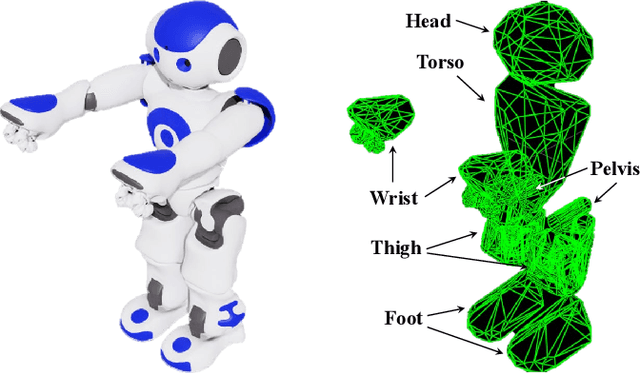
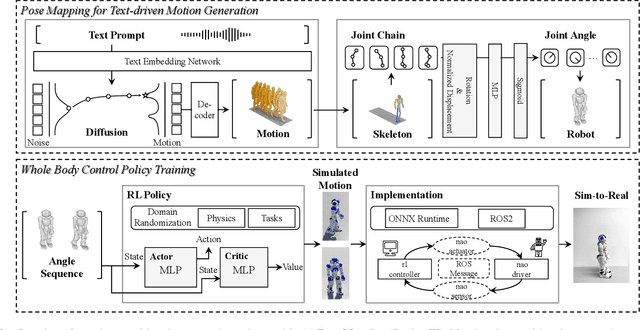
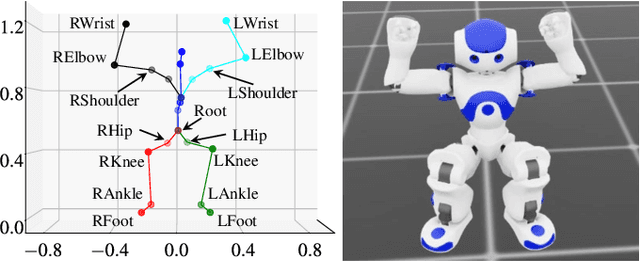
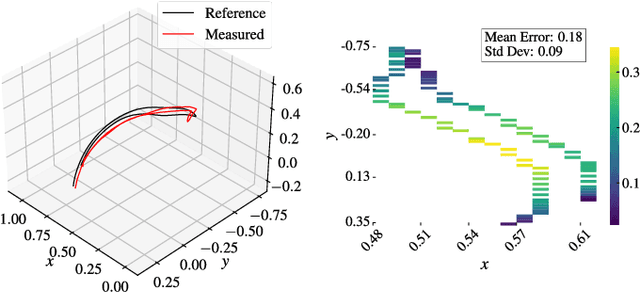
Abstract:Human motion retargeting for humanoid robots, transferring human motion data to robots for imitation, presents significant challenges but offers considerable potential for real-world applications. Traditionally, this process relies on human demonstrations captured through pose estimation or motion capture systems. In this paper, we explore a text-driven approach to mapping human motion to humanoids. To address the inherent discrepancies between the generated motion representations and the kinematic constraints of humanoid robots, we propose an angle signal network based on norm-position and rotation loss (NPR Loss). It generates joint angles, which serve as inputs to a reinforcement learning-based whole-body joint motion control policy. The policy ensures tracking of the generated motions while maintaining the robot's stability during execution. Our experimental results demonstrate the efficacy of this approach, successfully transferring text-driven human motion to a real humanoid robot NAO.
Natural Language Processing in Support of Evidence-based Medicine: A Scoping Review
May 28, 2025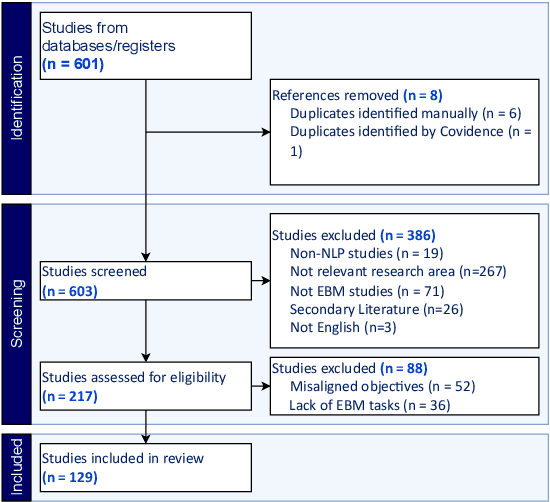
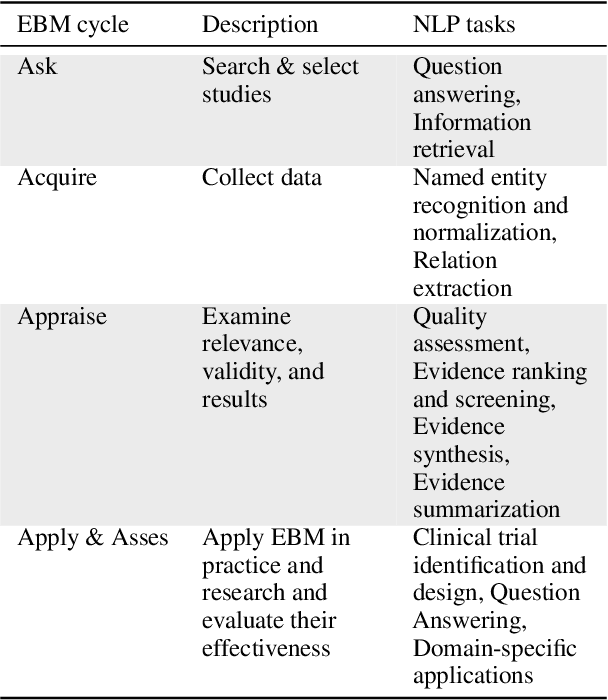
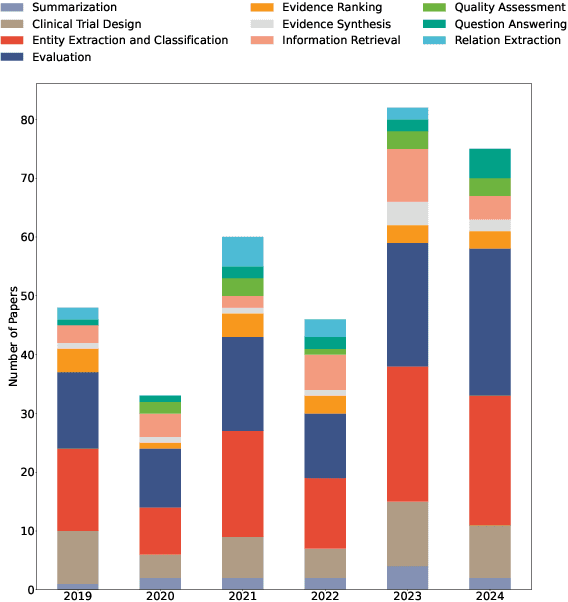
Abstract:Evidence-based medicine (EBM) is at the forefront of modern healthcare, emphasizing the use of the best available scientific evidence to guide clinical decisions. Due to the sheer volume and rapid growth of medical literature and the high cost of curation, there is a critical need to investigate Natural Language Processing (NLP) methods to identify, appraise, synthesize, summarize, and disseminate evidence in EBM. This survey presents an in-depth review of 129 research studies on leveraging NLP for EBM, illustrating its pivotal role in enhancing clinical decision-making processes. The paper systematically explores how NLP supports the five fundamental steps of EBM -- Ask, Acquire, Appraise, Apply, and Assess. The review not only identifies current limitations within the field but also proposes directions for future research, emphasizing the potential for NLP to revolutionize EBM by refining evidence extraction, evidence synthesis, appraisal, summarization, enhancing data comprehensibility, and facilitating a more efficient clinical workflow.
FlowAgent: Achieving Compliance and Flexibility for Workflow Agents
Feb 20, 2025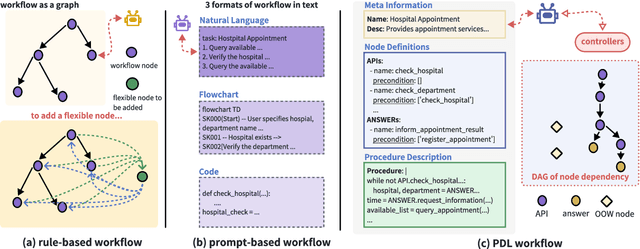

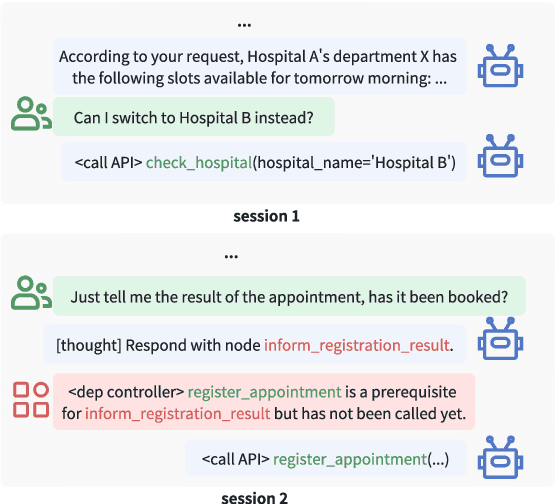

Abstract:The integration of workflows with large language models (LLMs) enables LLM-based agents to execute predefined procedures, enhancing automation in real-world applications. Traditional rule-based methods tend to limit the inherent flexibility of LLMs, as their predefined execution paths restrict the models' action space, particularly when the unexpected, out-of-workflow (OOW) queries are encountered. Conversely, prompt-based methods allow LLMs to fully control the flow, which can lead to diminished enforcement of procedural compliance. To address these challenges, we introduce FlowAgent, a novel agent framework designed to maintain both compliance and flexibility. We propose the Procedure Description Language (PDL), which combines the adaptability of natural language with the precision of code to formulate workflows. Building on PDL, we develop a comprehensive framework that empowers LLMs to manage OOW queries effectively, while keeping the execution path under the supervision of a set of controllers. Additionally, we present a new evaluation methodology to rigorously assess an LLM agent's ability to handle OOW scenarios, going beyond routine flow compliance tested in existing benchmarks. Experiments on three datasets demonstrate that FlowAgent not only adheres to workflows but also effectively manages OOW queries, highlighting its dual strengths in compliance and flexibility. The code is available at https://github.com/Lightblues/FlowAgent.
LUCY: Linguistic Understanding and Control Yielding Early Stage of Her
Jan 27, 2025



Abstract:The film Her features Samantha, a sophisticated AI audio agent who is capable of understanding both linguistic and paralinguistic information in human speech and delivering real-time responses that are natural, informative and sensitive to emotional subtleties. Moving one step toward more sophisticated audio agent from recent advancement in end-to-end (E2E) speech systems, we propose LUCY, a E2E speech model that (1) senses and responds to user's emotion, (2) deliver responses in a succinct and natural style, and (3) use external tool to answer real-time inquiries. Experiment results show that LUCY is better at emotion control than peer models, generating emotional responses based on linguistic emotional instructions and responding to paralinguistic emotional cues. Lucy is also able to generate responses in a more natural style, as judged by external language models, without sacrificing much performance on general question answering. Finally, LUCY can leverage function calls to answer questions that are out of its knowledge scope.
A MapReduce Approach to Effectively Utilize Long Context Information in Retrieval Augmented Language Models
Dec 17, 2024



Abstract:While holding great promise for improving and facilitating healthcare, large language models (LLMs) struggle to produce up-to-date responses on evolving topics due to outdated knowledge or hallucination. Retrieval-augmented generation (RAG) is a pivotal innovation that improves the accuracy and relevance of LLM responses by integrating LLMs with a search engine and external sources of knowledge. However, the quality of RAG responses can be largely impacted by the rank and density of key information in the retrieval results, such as the "lost-in-the-middle" problem. In this work, we aim to improve the robustness and reliability of the RAG workflow in the medical domain. Specifically, we propose a map-reduce strategy, BriefContext, to combat the "lost-in-the-middle" issue without modifying the model weights. We demonstrated the advantage of the workflow with various LLM backbones and on multiple QA datasets. This method promises to improve the safety and reliability of LLMs deployed in healthcare domains.
Deciphering genomic codes using advanced NLP techniques: a scoping review
Nov 25, 2024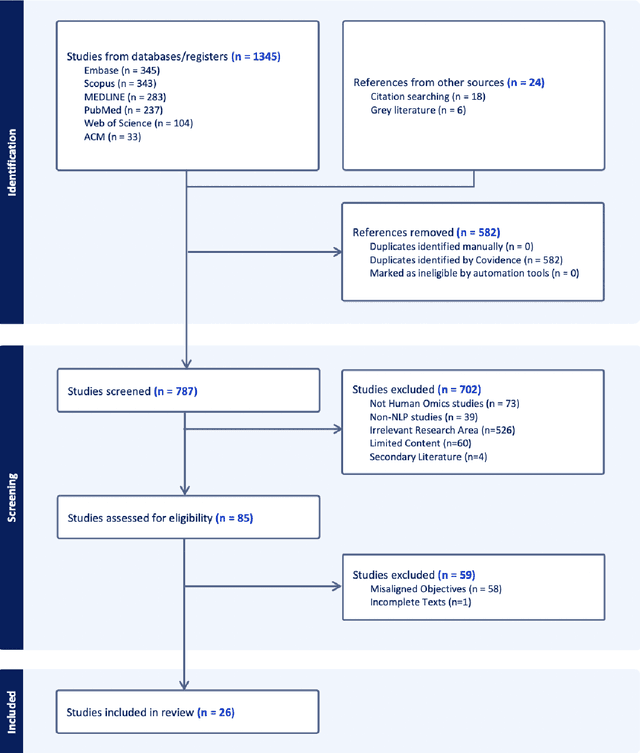
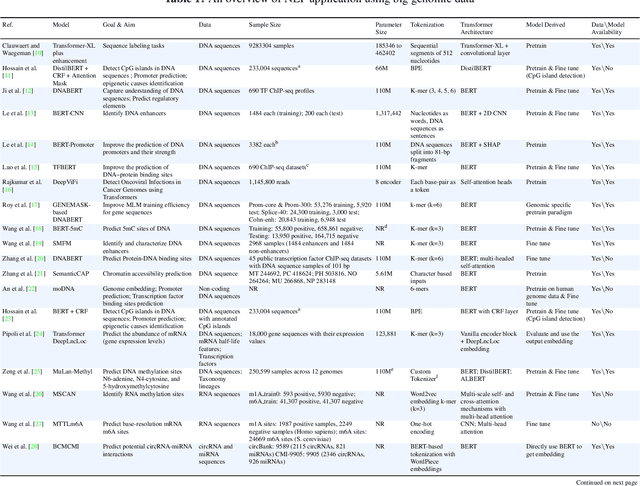
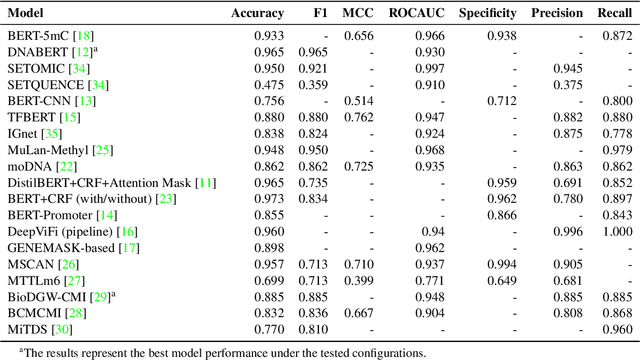
Abstract:Objectives: The vast and complex nature of human genomic sequencing data presents challenges for effective analysis. This review aims to investigate the application of Natural Language Processing (NLP) techniques, particularly Large Language Models (LLMs) and transformer architectures, in deciphering genomic codes, focusing on tokenization, transformer models, and regulatory annotation prediction. The goal of this review is to assess data and model accessibility in the most recent literature, gaining a better understanding of the existing capabilities and constraints of these tools in processing genomic sequencing data. Methods: Following Preferred Reporting Items for Systematic Reviews and Meta-Analyses (PRISMA) guidelines, our scoping review was conducted across PubMed, Medline, Scopus, Web of Science, Embase, and ACM Digital Library. Studies were included if they focused on NLP methodologies applied to genomic sequencing data analysis, without restrictions on publication date or article type. Results: A total of 26 studies published between 2021 and April 2024 were selected for review. The review highlights that tokenization and transformer models enhance the processing and understanding of genomic data, with applications in predicting regulatory annotations like transcription-factor binding sites and chromatin accessibility. Discussion: The application of NLP and LLMs to genomic sequencing data interpretation is a promising field that can help streamline the processing of large-scale genomic data while also providing a better understanding of its complex structures. It has the potential to drive advancements in personalized medicine by offering more efficient and scalable solutions for genomic analysis. Further research is also needed to discuss and overcome current limitations, enhancing model transparency and applicability.
Leveraging Open Knowledge for Advancing Task Expertise in Large Language Models
Aug 28, 2024



Abstract:The cultivation of expertise for large language models (LLMs) to solve tasks of specific areas often requires special-purpose tuning with calibrated behaviors on the expected stable outputs. To avoid huge cost brought by manual preparation of instruction datasets and training resources up to hundreds of hours, the exploitation of open knowledge including a wealth of low rank adaptation (LoRA) models and instruction datasets serves as a good starting point. However, existing methods on model and data selection focus on the performance of general-purpose capabilities while neglecting the knowledge gap exposed in domain-specific deployment. In the present study, we propose to bridge such gap by introducing few human-annotated samples (i.e., K-shot) for advancing task expertise of LLMs with open knowledge. Specifically, we develop an efficient and scalable pipeline to cost-efficiently produce task experts where K-shot data intervene in selecting the most promising expert candidates and the task-relevant instructions. A mixture-of-expert (MoE) system is built to make the best use of individual-yet-complementary knowledge between multiple experts. We unveil the two keys to the success of a MoE system, 1) the abidance by K-shot, and 2) the insistence on diversity. For the former, we ensure that models that truly possess problem-solving abilities on K-shot are selected rather than those blind guessers. Besides, during data selection, instructions that share task-relevant contexts with K-shot are prioritized. For the latter, we highlight the diversity of constituting experts and that of the fine-tuning instructions throughout the model and data selection process. Extensive experimental results confirm the superiority of our approach over existing methods on utilization of open knowledge across various tasks. Codes and models will be released later.
 Add to Chrome
Add to Chrome Add to Firefox
Add to Firefox Add to Edge
Add to Edge